For all the rich maths tasks and probing questions in this series, and for the pedagogy behind the concept, please visit the Probing Maths Questions Index page.
At the end of last year, I wrote a post explaining how I am a much bigger fan of spending my time planning questions these days, as opposed to resources.
Resources, such as PowerPoints and worksheets, can be inflexible and time consuming to create. If I discover something is wrong with my worksheet during the lesson, it is kind of too late. And the amount of hours of my life I have wasted messing around with fancy animations on PowerPoint – having equations bounce in from all angles – doesn’t bare thinking about.
Whereas you can think of questions anywhere and any time – I am at my most creative when washing up or when my wife is watching Made in Chelsea. More importantly, they lead to far more dynamic and better differentiated lessons. The same initial prompt or activity can be used with students of vastly differing ages and abilities by carefully selecting which questions you give to who. And if a question isn’t working, then try another one.
In that previous post, I explained how I gave a single prompt to a room full of teachers and challenged them to come up with as many interesting, probing questions as they could in 7 minutes. You will see on the post the quality that they came up with, and the resulting PowerPoint of this activity is here.
I have since used this lesson with Year 7s and Year 11s, and it has gone down a storm.
Now, I reckon we could be onto something here. With the talent, experience and (I don’t think it is too far to go to say) genius that read this blog, we can come up with some amazing rich, probing questions that will give us all some high quality, fun, engaging, challenging, well differentiated lessons.
So, I propose to offer up one prompt or activity each month, and invite you lovely readers to suggest probing questions to go along with it. And then, at the end of the month I will compile them all into a lovely PowerPoint and share them on this blog. This will only work if people get involved, and if everyone reading this shares just one question, then we are onto a winner.
So, what is the first activity, I hear you say?…
TASK 1 – The Factors and Multiples Game
This is an absolutely classic activity, that I first saw years ago on NRICH, and which I have been using, adapting and extending ever since.
The game is designed for two players (although there is a lovely one player twist), and is initially played on a 1-100 square grid:
The rules are very simple:
- Players take it in turns to cross off a number from the grid
- You can only cross off a number that is either a Factor or a Multiple of the previous number
- You cannot cross off a number that has already been crossed off
- If you cannot go, you lose that round
Here is how a game might start – notice how the moves are recorded on the right:
And the game would carry on until a player cannot go.
So, that is all well and good for practising the basics of Factors and Multiples, and indeed I would start all students off in exactly the same way, playing the game against each other until they are happy with the rules and I happy that they have a solid understanding of factors and multiples.
But now, can we come up with a series of probing questions that we could give to different students to challenge and engage them, and deepen their level of mathematical thinking as they continue to play the game?
Here are a few that I have used in the past to get the ball rolling:
Notice how some questions are open, and some are closed. Some will take a matter of minutes, other a number of lessons. Some will be suitable for one group of students, and others for another group. But with a bank of these up my sleeve, I can confidently walk around the room, see how different students are getting on with the game, and select the question to give them to challenge and engage them.
As I say, if everyone reading this can come up with one question, posted in the comments, we will soon build up a huge collection that could keep this excellent task going for a good few lessons. Feel free to change any aspect of the game, be it the rules, the grid size, whatever you like. Let you imagination run wild. And it doesn’t matter if you don’t know the answer to the question you are asking, as long as it is intriguing, we will take it 🙂
And at the end of the month, I will compile the activity and questions together into a lovely PowerPoint and share it will you all. So, please spread the word. The Probing Question revolution starts here 🙂
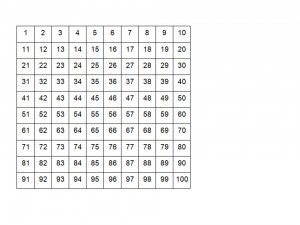
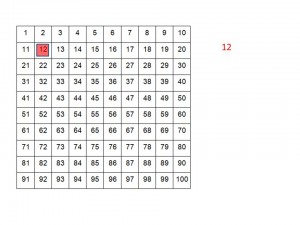
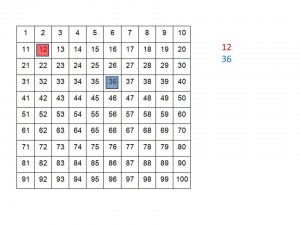


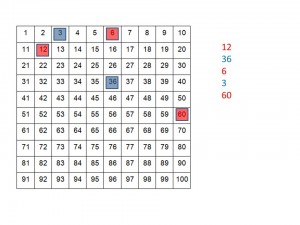
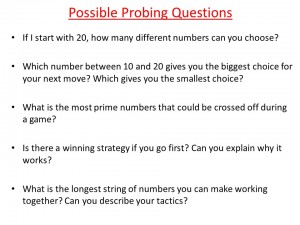
If I start with the number 27, is it better for you to then choose a factor or a multiple?
Which number has the most factors?
What is the smallest number of turns before you can choose a number which is neither a factor nor a multiple of the original number?
Just thought of another one myself…
What is the longest bigger-smaller-bigger-smaller-bigger-etc sequence you can make?
e.g. 2, 10, 5, 30, 6, 42…
Love the concept! Great timing. Just when I was planning a lesson on factors and multiples.
How many prime numbers will automatically end the game when 1 has been removed from play?
Also what is the smallest prime number that will end the game when you have removed 1?
Loving these! Dave’s suggestion gave me another idea I’ve never thought about:
How does the winning strategy change if 1 is removed?
What is the fewest number of goes you need to win in that situation?
1. What if the grid was only made on even numbers – is the best starting number still the same for your winning strategy?
2. What if you couldn’t use a number on the same line of the 100 grid, is it any harder to win?
What if when you played he game you had to take it in turns to pick a factor, multiple, factor, multiple and you didn’t get to choose which one each time, now what is the best number to start with?
Great ideas Sam!
Just realised my “how does the winning strategy change if 1 was removed?” question is a bit trivial.
So, how about…
How does the winning strategy change if 1 is removed BUT you can’t start on a prime?
Keep the questions coming 🙂
How many ways can you win the game in only 2 goes (p1, p2, p1)?
What’s the longest ascending/descending chain you can make?
Really love this activity, here are some questions I created to extend the learning of my class.
• How long can you go by avoiding all the prime numbers?
• How far can you get by avoiding multiples of 10?
• What is the longest string of numbers you can get?
• Is it possible to get past 73? (the highest score recorded on the N-Rich website)
• Can you prove what the highest score attainable is?
• Is it possible to cross out all 100 numbers?
For those pupils who require support for this task, you could create a 1-50 grid instead which means the calculations aren’t as big and they are able to access the maths all the same. Questions to ask these pupils could be;
• If your partner chooses the number 15 to start with, what numbers could you choose? What if they choose 7? What if they choose 37?
• How many prime numbers had been chosen once the game had finished?
Absolutely fantastic, Gareth. A brilliant selection of questions!